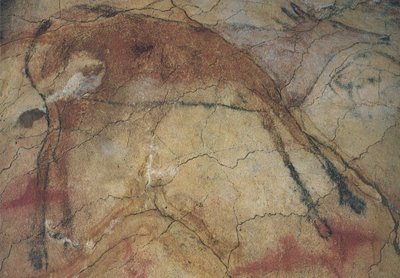
At the earliest red dawn of humanity, our ancestors slowly learned to use stone tools. For more than 2 million years they used stones in the same way: to bash or chop. It was a brutish existence that left no traces of art or culture behind.
Then, during the upper paleolithic period (35,000 to 12,000 years ago) stone technology took a great leap forward. Our ancestors learned how to select certain rocks that could be shaped into blades-- longer and lighter with more cutting surface. Using these stones, they developed tool making techniques that gave them ten times the cutting edge from the same sized stone.
This transformed their world. They could now use sharpened rocks for spear points and projectiles. They could cut with greater precision and for the first time make use of antler, ivory and bone. Hunting became easier. Conceptual thinking became more important to survival. The first signs of symbolic thought emerged. It was in this environment that the very first art began to appear, painted on cave walls and etched in bone. More artistic progress was made in those 25,000 years than in the preceding 2 million years combined.
Since those fragile beginnings, art continued to flourish in tandem with technology.
For example, Beethoven was able to revolutionize music partially because the invention of the piano gave him greater range and expressive capability than previous composers who grew up using the harpsichord.
And illustration art only became a phenomenon in the late 19th century when printing and photographic technology improved enough to reproduce artwork vividly and accurately for mass produced books and magazines. Without half tone engraving, there would have been no golden age of illustration.
It is useful to remember this long history in an era when technology sometimes seems dehumanizing and oppressive. Technology may push aside traditional art forms such as drawing and painting in favor of strange new art forms that screech and light up and move. But even the most sentimental among us (and I may qualify for that category myself) need to remain open minded as we assess the impact of technology on art.
The reason for my long, boring digression is that I want to chat in the next few installments about the nature of computers and digital art. I would love to engage in a dialogue with you dear readers about the future of art, and to be educated by you as I invariably am.
Are you ready?






